12 Most Common Types of Butterflies in Connecticut (With Pictures)
-
Brooke Bundy
- Last updated:
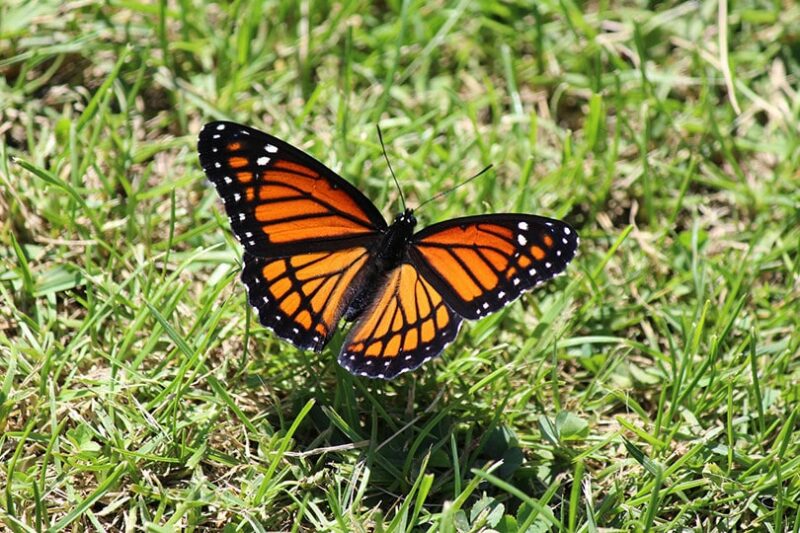
Over 100 species of butterflies can be spotted in Connecticut depending on the location and the time of year. Some butterflies spend their entire lives lingering in local fields, while others make your backyard their vacation oasis for a season before migrating south for the winter. Here are butterfly species that aren’t too hard to find in the state of Connecticut due to their large population or mostly permanent residence.
The 12 Common Types of Butterflies in Connecticut
1. Red Admiral
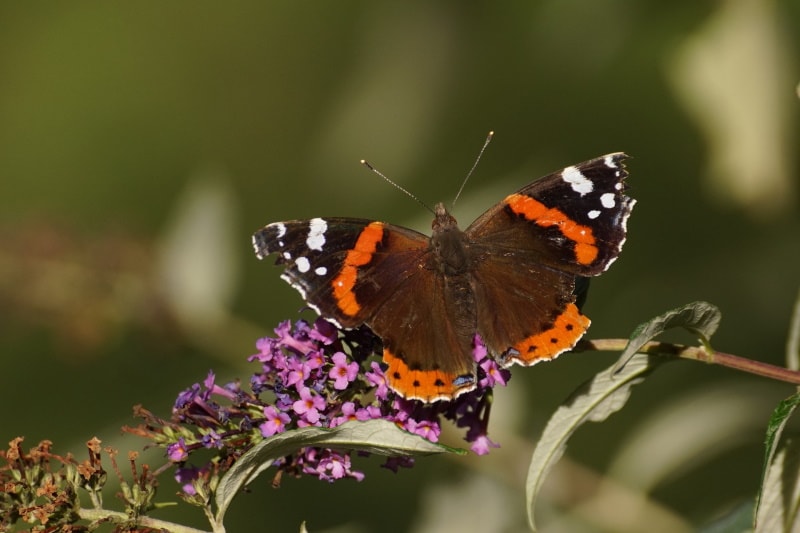
| Scientific Name | Vanessa atalanta |
| Habitat | All terrain |
| Lifespan | Up to 10 months |
One of the only migratory butterflies on our list, the Red Admiral is a recurring spring/summer visitor to the Constitution State. The center of their bodies is dark brown, with a thick orange ring around the wings and black and white markings on the edges. These creatures are content to live in almost any environment, but they prefer moist woods where they might find fermented fruit.
2. Viceroy
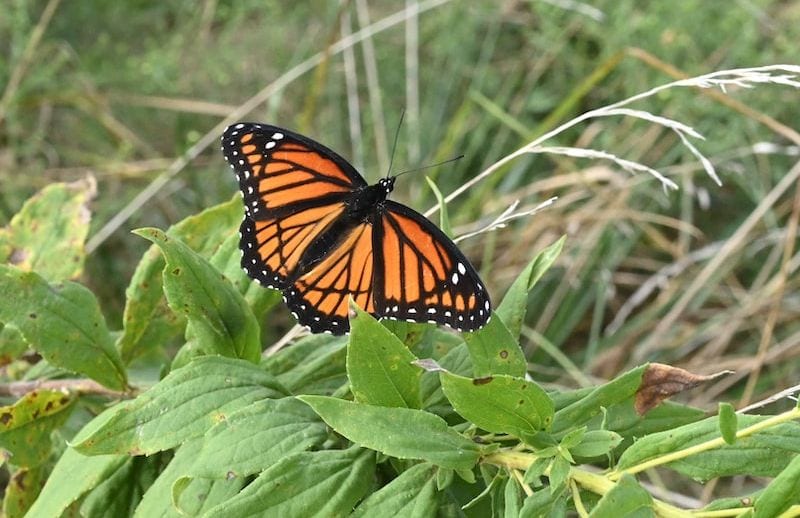
| Scientific Name | Limenitis archippus |
| Habitat | Wetlands, marshes, meadows |
| Lifespan | 3-4 weeks adult stage |
Although you’ll often find this butterfly zipping through Connecticut, the Viceroy is actually the state butterfly of Kentucky. These guys look like monarch butterflies but can be distinguished by a black horizontal stripe near the bottom of their wings. Additionally, Monarchs are migratory species, while the Viceroy stays in Connecticut year-round. Viceroys like to live in moist areas, often taking residence in Aspen and Willow trees.
3. Hackberry Emperor
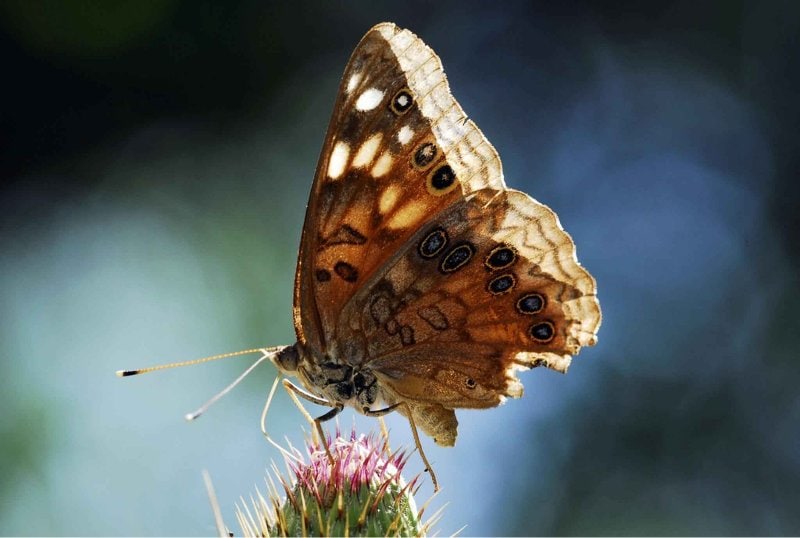
| Scientific Name | Asterocampa celtis |
| Habitat | Woods, parks, yards; dependent on hackberry trees |
| Lifespan | 6-14 days adult stage |
The Hackberry Emperor has a muted orange and brown pattern on its wings. Their unusual dietary requirement for sodium coaxes them into eating human sweat, hence it may be quite easy to convince one to land on your hand. Among other strange meals, these butterflies eat decaying animals as well as sap from hackberry trees, which is the only place they like to nest. Unlike most butterflies, this species isn’t attracted to flowers and may even avoid them.
4. Red-spotted Purple
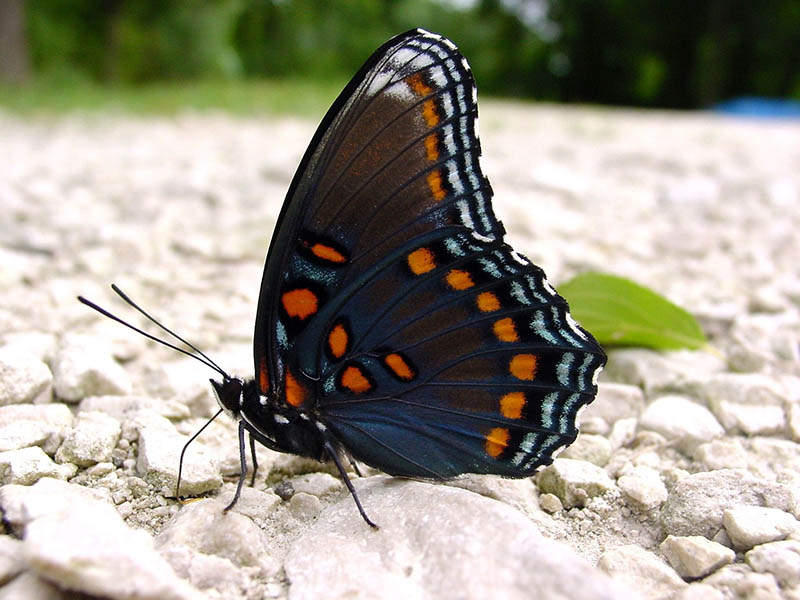
| Scientific Name | Limenitis arthemis astyanax |
| Habitat | Moist areas such as marshes |
| Lifespan | 6 to 14 days adult stage |
This strikingly beautiful butterfly spends its days hovering over swampy water and drinking tree sap and rotten fruit. They’ll host in a variety of trees that grow in wetland areas, such as willows, aspens, poplars, and oaks. The colors of its wings vary slightly depending on the individual creature, but most have cerulean blue wings with red dots along the borders. Their bodies tend to be darker towards the center of their wings and become more colorful towards the edges.
5. Mourning Cloak
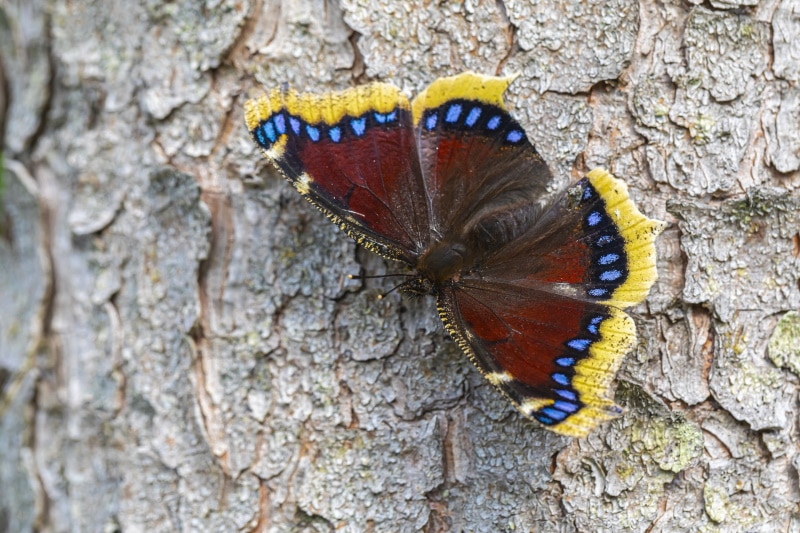
| Scientific Name | Scientific Name |
| Habitat | Deciduous forests |
| Lifespan | 10 months |
This butterfly has thick black wings fringed with small blue dots and a creamy trim. Preferring to spend their days in isolation, the Mourning Cloak looks and acts like a widow grieving with Victorian dignity. Even so, their lives are far from futile. The Mourning Cloak has one of the longest lifespans of all known butterflies, often living for about 10 months. This species resides in forests mostly eating sap and fruit. Because they live for almost a year, Morning Cloaks are required to hibernate during the winter months as adults. A chemical in their veins keeps their blood from freezing as they hide away in a tree during the coldest months of the year.
6. Great Spangled Fritillary

| Scientific Name | Speyeria cybele |
| Habitat | Open areas |
| Lifespan | 30-40 days adult stage |
With a name containing the words “great spangled,” you might expect this fritillary species to don patriotic colors like red, white, and blue. However, this butterfly has an orange and black pattern with irregular markings such as dots and semi-circles. The Great Spangled Fritillary is a beauty to behold. They love wide open spaces and the warmth of the full sun, so you might spot them during a meadow picnic or even at a ball game. They mostly feed on nectar from milkweed and coneflowers.
7. Azure

| Scientific Name | Celastrina ladon |
| Habitat | Wooded areas |
| Lifespan | 2-5 days adult stage |
The Azure is easy to spot with its tiny body and blue wings. They’re one of the first butterflies to welcome spring, but they don’t stick around for long. Adults have a brief lifespan of only 2-5 days. They like to eat nectar from milkweed plants and live in dogwood trees. The larvae have a symbiotic relationship with ants, who feed and protect them in exchange for eating their excrement which is rich in sugar.
8. Eastern Tailed-Blue
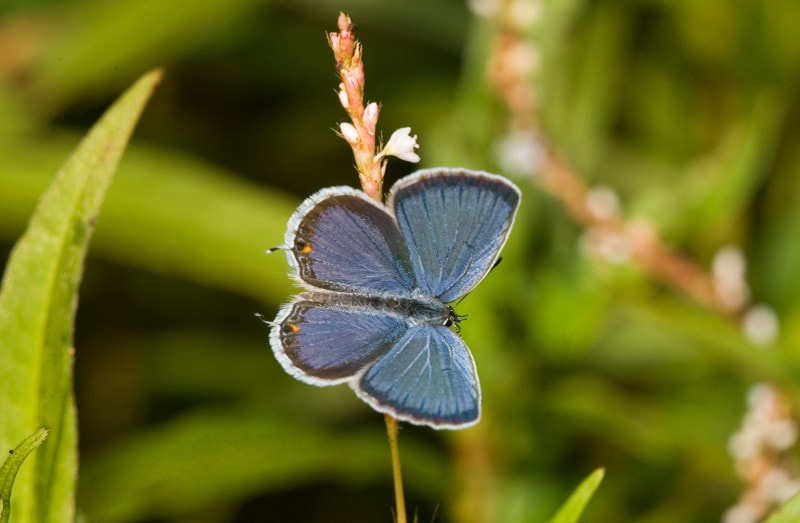
| Scientific Name | Cupido comyntas |
| Habitat | Open areas |
| Lifespan | 4-10 days adult stage |
You might see the Eastern Tailed-Blue flapping their wings through open fields on a sunny day. They look similar to swallowtails and have tiny hair-like tails on the bottom tips of their wings, but they actually belong to a different family. Their fuzzy wings are strikingly different colors between males and females. Males have deep blue wings with a brown outline around the edges, which are trimmed in white. Females also have white trimmed wings, but their bodies are lighter blue, brown, or a blend of both. The Eastern Tailed-Blue adult feeds on nectar from low-lying flowers such as wild strawberries and clovers.
9. Coral Hairstreak
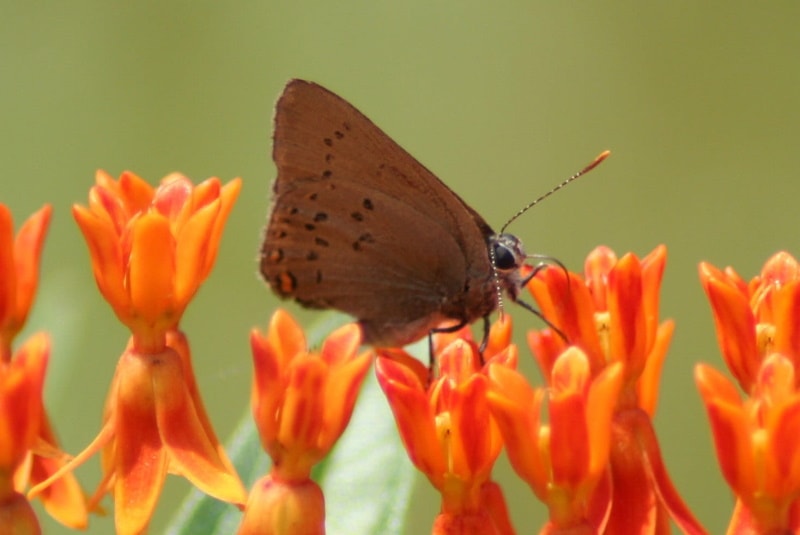
| Scientific Name | Cupido comyntas |
| Habitat | Cherry and plum trees |
| Lifespan | Up to 4 weeks |
The Coral Hairstreak is a small butterfly that has a brownish gray body with coral and black spots that are outlined by thin white and black rings. Although we don’t know exactly how long they live, almost all sightings of the adult butterfly occur between June and July, and other species in the Hairstreak family of butterflies only live up to a month. The Coral Hairstreak lives mostly in cherry and plum trees, where they conveniently feast off the fruit. You might see one venturing out to gardens and fields in search of coveted orange milkweed blossoms.
10. American Copper
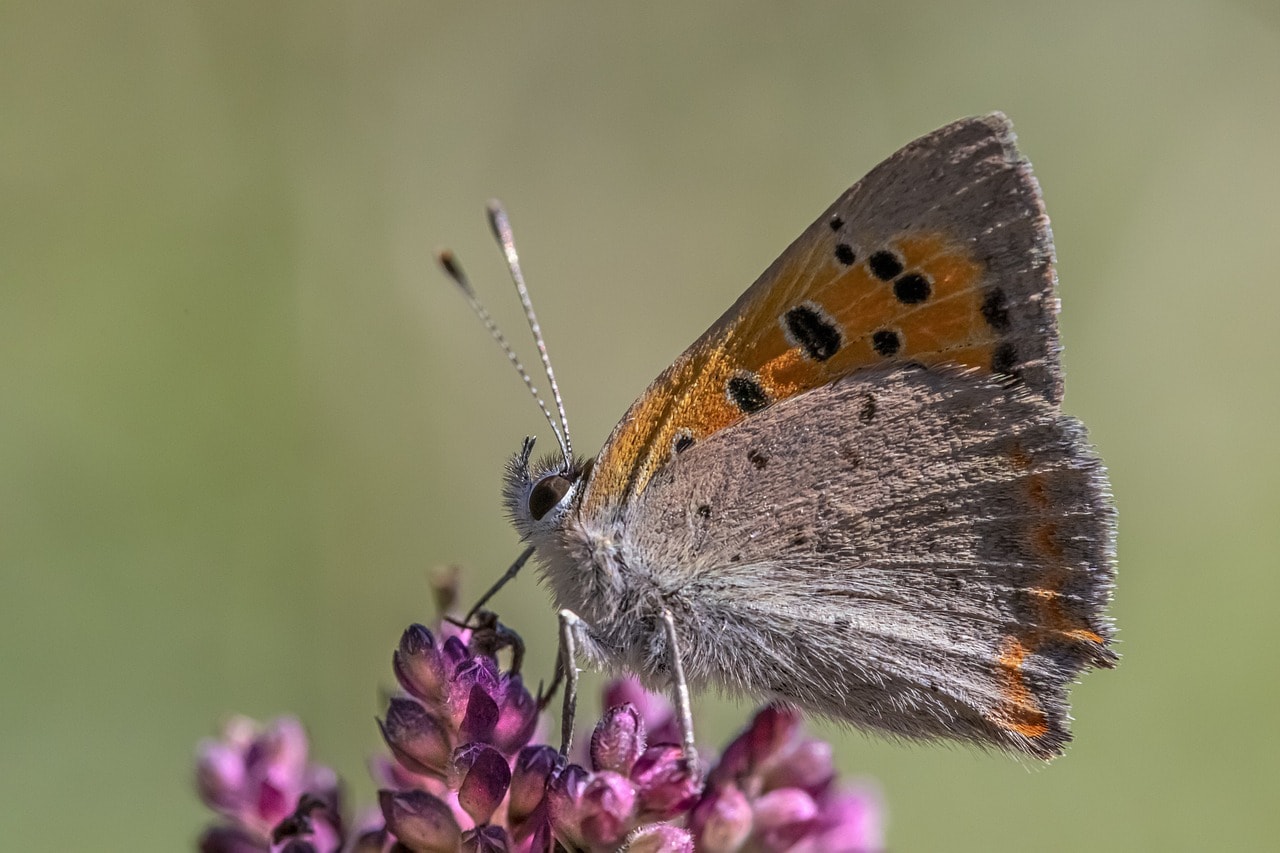
| Scientific Name | Lycaena phlaeas |
| Habitat | Open areas |
| Lifespan | 2 weeks adult stage |
These small butterflies are characterized by the slate gray color under their wings, which are mostly orange with black spots on top and mostly brown on the bottom half. The American Copper has many nicknames in Connecticut, such as the Little Copper and Common Copper since they’re so abundant in the region. As larvae, American Copper eat sheep sorrel, which is their host plant. Once they hatch as adults, American Coppers sip on nectar from meadow flowers such as butterfly weed.
11. Eastern Tiger Swallowtail
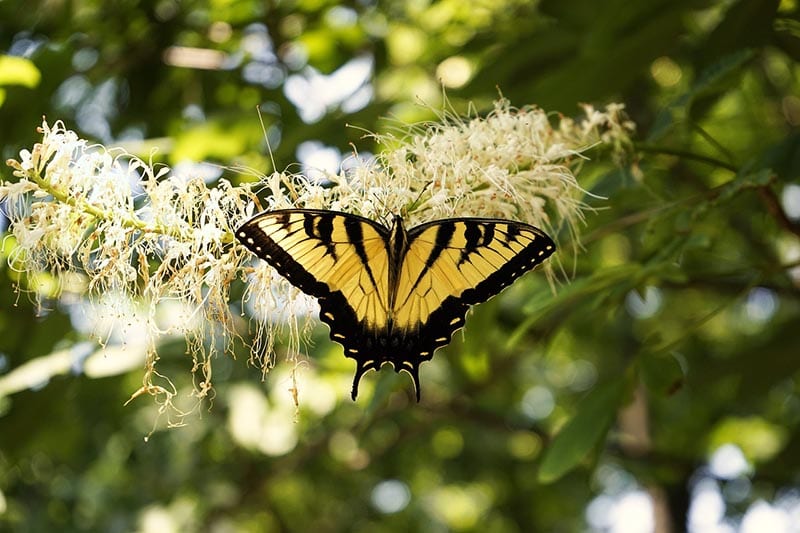
| Scientific Name | Papilio glaucus |
| Habitat | Gardens |
| Lifespan | 14 days |
These large butterflies are fairly easy to recognize given their size and striking colors. All males have the same yellow, black, and blue markings with a red dot on the bottom center of their wings. However, females have two variations, a light-yellow form and a dark-blue form. Both types have dark blue coloring near the base of their wings, which end with a long black tail. The Eastern Tiger Swallowtail is a frequent garden visitor, as they love drinking nectar from common backyard flowers. They live in various trees and tend to fly solo.
12. Clouded Sulphur
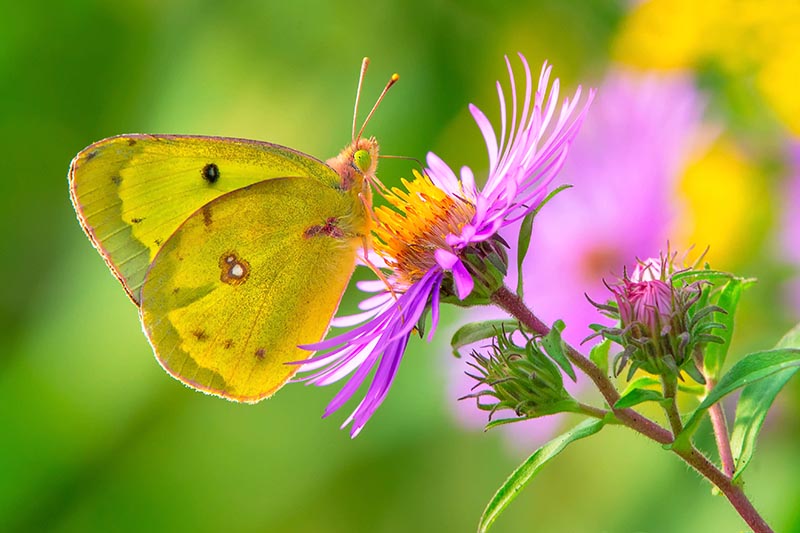
| Scientific Name | Colias philodice |
| Habitat | Most environments |
| Lifespan | 2-24 days in adult stage |
This banana-colored butterfly flourishes through the United States, making its home almost anywhere. Males have a solid black border around their wings, while females have yellow dots around the edges. You can find the Clouded Sulphur year-round in Connecticut where they love to feed on nectar and use plants in the pea family as their host.
Conclusion
Although all of these 12 species reside in Connecticut, you might have to take a hike to spot a few of the ones who like to dwell quietly in the countryside. If you want to attract more butterflies to your backyard, consider planting flowers such as butterfly bush and milkweed, which are favorite foods for many species. Through the summer, you’ll likely see a bounty of different butterfly species, but not all of them call Connecticut home year-round. However, you can see most of the ones on our list at some stage in their life in all seasons, whether they’re flying as adults, munching on leaves as a caterpillar, or overwintering in a chrysalis.
- https://www.news-leader.com/story/life/2014/11/12/red-admiral-butterfly-vanessa-atalanta/18935013/
- https://nhpbs.org/natureworks/viceroy.htm
- https://www.butterflyidentification.com/viceroy.htm
- https://www.butterflyidentification.com/hackberry-emperor.htm
- https://www.butterfliesathome.com/red-spotted-purple-butterfly.htm
- https://www.butterfliesathome.com/mourning-cloak-butterfly.htm
- https://www.naba.org/chapters/nabanj/butterflies/great_spangled_fritillary.html
- https://insectic.com/spring-azure-butterfly/
- https://nhpbs.org/wild/easterntailedblue.asp
- https://www.animalspot.net/american-copper-butterfly.html
- https://wisconsinbutterflies.org/butterfly/species/27-american-copper
- https://www.butterfliesathome.com/tiger-swallowtail-butterfly.htm
- https://www.butterflyidentification.com/clouded-sulphur.htm
- https://www.butterflyidentification.com/butterflies-in-us/connecticut-butterflies
- https://birdwatchinghq.com/butterflies-in-connecticut/
- https://uwm.edu/field-station/butterflies-overwinter/
Featured Image Credit: Domianick, Pixabay
Contents
